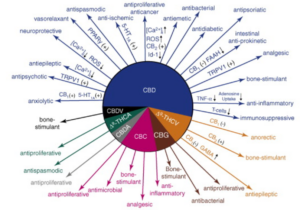Medicinal varieties of hemp
The so-called medicinal hemp refers to varieties of Cannabis sativa L. plant specie that have been selected because of their great number of inflorescences which produce phytochemical substances of great value, as active medicinal principles.
Feminine inflorescences have some specialized hairs on their surface, which are called glandular trichomes. They are the ones responsible for producing the different phytochemical substances, among them the cannabinoid (as THC, CBD, CBG,…), terpenes, flavonoids,…

There is a growing quantity of evidence that supports the effectiveness of various of this phytochemical substances in the treatment of a wide range of affections, which include: chronical and severe pain, epilepsy, sleep disorders, multiple sclerosis, illnesses for gastrointestinal backflow, irritable bowel syndrome, spasticity, hypertension, and schizophrenia, among others (Pacher et al., 2005; Izzo et al., 2009; Hazekamp & Grotenhermen, 2010; Caraceni et al., 2014; Bruni et al., 2018; Pagano et al., 2022).

Figures 1 and 2 show a schema of the therapeutic value and the action mechanisms of the cannabinoids in treating different pathologies and states, respectively.

Figure 1. Therapeutic value of the cannabinoids for numerous pathologies or states. Taken from Pagano et al. 2022 2022.

Figure 2. Pharmacological effects and action mechanisms of non-psychotropic cannabinoids.
Abbreviations:
CBN, cannabinol; CBD, cannabidiol; D9-THCV, D9-tetrahydrocannabivarin; CBC, cannabichromene; CBG, cannabigerol; D9-THCA, D9-tetrahydrocannabinolic acid; TRPV1, transient receptor potential vanilloid type 1; PPARg, peroxisome proliferator-activated receptor g; ROS, reactive oxygen species; 5-HT1A, 5-hydroxytryptamine receptor subtype 1A; FAAH, fatty acid amide hydrolase.
(+), direct or indirect activation; ↑, increase; ↓, decrease.
Source: Izzo et al., 2009. 2009.
Additionally, it is highly interesting the growing scientific interest towards the antimicrobial properties of the phytochemical substances of hemp. Every time there are more publications that propose these hemp substances as alternatives in the fight against antibiotic-resistant bacteria a problem that, sadly, is more frequent every day (Aliferis et al., 2020).
This not only increases interest for the pharmaceutic market side, but also these antimicrobial properties of hemp suppose an additional benefit for practically all their derived products. There is special interest in areas like :
- the healthcare and hostelry (antimicrobial textiles like sheets, towels, working clothes, furniture, working tools…),
- in the farming area (naturally antibiotic food for livestock, antimicrobial lodging,…),
- in the construction area (insulations, materials with more resistance to fungi and other microorganisms…),
- for personal-use clothes (underwear, socks, shirts, sport or working clothes,…),
- food industry (antimicrobial packaging solutions, preventive foods,…),…
References
Aliferis KA and Bernard-Perron D (2020) Cannabinomics: Application of Metabolomics in Cannabis (Cannabis sativa L.) Research and Development. Front. Plant Sci. 11:554. doi: 10.3389/fpls.2020.00554
Bruni, N., Della Pepa, C., Oliaro-Bosso, S., Pessione, E., Gastaldi, D., and Dosio, F. (2018). Cannabinoid delivery systems for pain and inflammation treatment. Molecules 23:2478. doi: 10.3390/molecules23102478
Caraceni, P., Borrelli, F., Giannone, F. A., and Izzo, A. A. (2014). “Potential therapeutic applications of cannabinoids in gastrointestinal and liver diseases: focus on 19-tetrahydrocannabinol pharmacology,” in Cannabinoids ed. V. Di Marzo (Hoboken, NJ: John Wiley & Sons, Ltd), 219–260. doi: 10.1002/ 9781118451281.ch7
Hazekamp, A., and Grotenhermen, F. (2010). Review on clinical studies with Cannabis and cannabinoids 2005-2009. Cannabinoids 5, 1–21.
Izzo AA, Borrelli F, Capasso R, Di Marzo V, Mechoulam R. Non-psychotropic plant cannabinoids: new therapeutic opportunities from an ancient herb. Trends Pharmacol Sci. 2009 Oct;30(10):515-27. doi: 10.1016/j.tips.2009.07.006. Epub 2009 Sep 2. Erratum in: Trends Pharmacol Sci. 2009 Dec;30(12):609. PMID: 19729208.
Pacher, P., Batkai, S., and Kunos, G. (2005). “Cardiovascular pharmacology of cannabinoids,” in Cannabinoids, ed. E. Perwee (Berlin: Springer-Verlag), 599– 625. doi: 10.1007/3-540-26573-2_20
Pagano C, Navarra G, Coppola L, Avilia G, Bifulco M, Laezza C. Cannabinoids: Therapeutic Use in Clinical Practice. International Journal of Molecular Sciences. 2022; 23(6):3344. https://doi.org/10.3390/ijms23063344.



